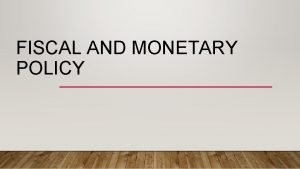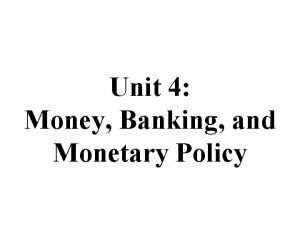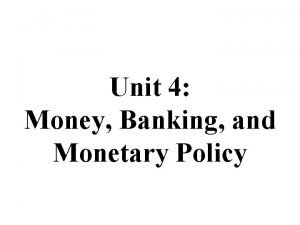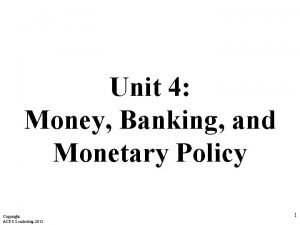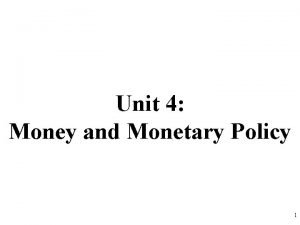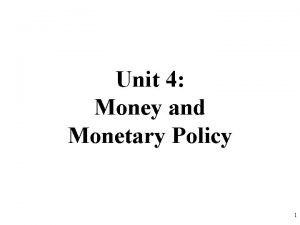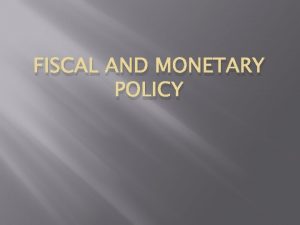Fiscal and Monetary Policy Chapter 14 Essential Question








- Slides: 8

Fiscal and Monetary Policy Chapter 14 Essential Question: How do policymakers use fiscal and monetary policy to stabilize the economy?

Intro • Fiscal policy and monetary policy are easy to confuse. • Fiscal policy refers to gov’t taxing and spending. • How much the gov’t takes in, then spends out. • Monetary policy refers to changing money supply & interest rates. • How much money is out there, and the rate of interest earned/paid. • Both are “buttons” the gov’t can push to fiddle with the economy.

Three views on this 1. Classical economists • Adam Smith – gov’t should stay out of the economy • View was challenged by Great Depression and FDR 2. Keynesian economists • John Maynard Keynes said the gov’t should get involved in economy during bad times. • Deficit spending was viewed as okay; it may jumpstart the economy. • This focuses on fiscal policy—taxing and spending.

Cont. 3. Monetarism and Friedman • Milton Friedman said the supply of money out there is key. • Said Great Depression was b/c of too little money. • Federal Reserve Board can change the money supply, so this focuses on monetary policy. • Increase money supply inflation speeds up • Decrease money supply inflation slows (or deflation)

Fiscal policy “tools” • Remember, fiscal policy refers to taxing and spending • The economy may be going too slow (contracting) or too fast (expanding) • If slow, we go to expansionary fiscal policies (we want to speed it up)… 1. Cut taxes (more $ for us to spend) 2. Increase gov’t spending • Tax cuts for individuals is called demand-side economics • Tax cuts for biz & wealthy is called supply-side economics • If fast, we go to contractionary fiscal policies (we want to slow it down)… 1. Increase taxes (less $ for us to spend) 2. Decrease gov’t spending

Monetary policy “tools” • Remember, monetary policy deals with the (1) money supply and (2) interest rates. • Decisions are made by the Federal Reserve (board, chairman). • There are 12 federal reserve banks/districts. • “The Fed” (1) alters the money supply by… • Easy-money policy – increases the $ supply to boost economic growth (and thus lower unemployment) • Tight-money policy – decrease the $ supply to slow growth (and thus slow inflation) • The Fed also can play with “open market operations”—buy/sell bonds • The Fed also can adjust the reserve requirement of banks

Cont. • The Fed also (2) adjusts interest rates • The discount rate is the interest rate banks pay the Federal Reserve banks (the rate the “little” banks pay to the “big” banks) • Lower interest rates stimulates growth b/c we take loans to buy • Higher interest rates slows growth b/c we don’t take loans, instead we save our money

National Debt • Is the debt okay like Keynes said? • How big is it? Look: http: //www. usdebtclock. org/
 Contractionary vs expansionary fiscal policy
Contractionary vs expansionary fiscal policy Fiscal vs monetary policy
Fiscal vs monetary policy Unit 4 money banking and monetary policy
Unit 4 money banking and monetary policy Unit 4 money banking and monetary policy
Unit 4 money banking and monetary policy Unit 4 money and monetary policy
Unit 4 money and monetary policy Unit 4 money and monetary policy
Unit 4 money and monetary policy Unit 4 money and monetary policy
Unit 4 money and monetary policy Unit 3 aggregate demand aggregate supply and fiscal policy
Unit 3 aggregate demand aggregate supply and fiscal policy Tax multiplier formula
Tax multiplier formula

